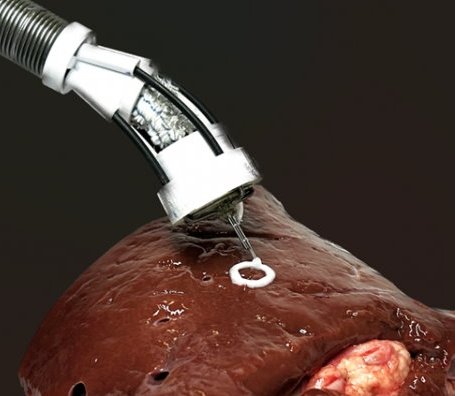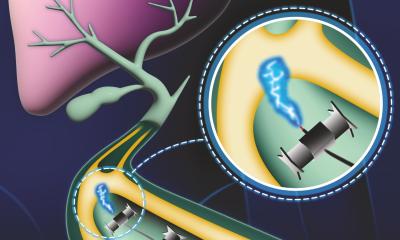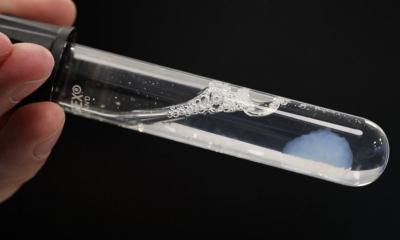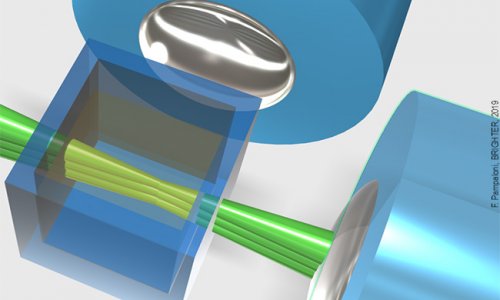Video • Potential for all-in-one endoscopic surgical tool
Soft robot for 3D bioprinting inside the human body
Researchers at the University of New South Wales (UNSW) unveil prototype device that can directly 3D print living cells onto internal organs and potentially be used as an all-in-one endoscopic surgical tool.
Engineers from UNSW Sydney have developed a miniature and flexible soft robotic arm which could be used to 3D print biomaterial directly onto organs inside a person’s body. 3D bioprinting is a process whereby biomedical parts are fabricated from so-called bioink to construct natural tissue-like structures. Bioprinting is predominantly used for research purposes such as tissue engineering and in the development of new drugs – and normally requires the use of large 3D printing machines to produce cellular structures outside the living body.
The new research from UNSW Medical Robotics Lab, led by Dr Thanh Nho Do and his PhD student, Mai Thanh Thai, in collaboration with other researchers from UNSW including Scientia Professor Nigel Lovell, Dr Hoang-Phuong Phan, and Associate Professor Jelena Rnjak-Kovacina is detailed in a paper published in Advanced Science.

Image source: UNSW; photo from Dr Thanh Do
Their work has resulted in a tiny flexible 3D bioprinter that has the ability to be inserted into the body just like an endoscope and directly deliver multilayered biomaterials onto the surface of internal organs and tissues.
The proof-of-concept device, known as F3DB, features a highly manoeuvrable swivel head that ‘prints’ the bioink, attached to the end of a long and flexible snake-like robotic arm, all of which can be controlled externally.
The research team say that with further development, and potentially within five to seven years, the technology could be used by medical professionals to access hard-to-reach areas inside the body via small skin incisions or natural orifices.
This system offers the potential for the precise reconstruction of three-dimensional wounds inside the body, such as gastric wall injuries or damage and disease inside the colon
Thanh Nho Do
Dr Do and his team have tested their device inside an artificial colon, as well as 3D printing a variety of materials with different shapes on the surface of a pig’s kidney. “Existing 3D bioprinting techniques require biomaterials to be made outside the body and implanting that into a person would usually require large open-field open surgery which increases infection risks,” said Dr Do, a Scientia Senior Lecturer at UNSW’s Graduate School of Biomedical Engineering (GSBmE) and Tyree Foundation Institute of Health Engineering (IHealthE). “Our flexible 3D bioprinter means biomaterials can be directly delivered into the target tissue or organs with a minimally invasive approach. This system offers the potential for the precise reconstruction of three-dimensional wounds inside the body, such as gastric wall injuries or damage and disease inside the colon. Our prototype is able to 3D print multilayered biomaterials of different sizes and shape through confined and hard-to-reach areas, thanks to its flexible body. Our approach also addresses significant limitations in existing 3D bioprinters such as surface mismatches between 3D printed biomaterials and target tissues/organs as well as structural damage during manual handling, transferring, and transportation process.”
Scientia Professor Nigel Lovell, Head of the GSBmE and Director of the IHealthE, added: “Currently, there are no commercially available devices that can perform in situ 3D bioprinting on internal tissues/organs distanced from the skin surface. Some other proof-of-concept devices have been presented, but they are much more rigid and tricky to use in complex and confined spaces inside the body.”
The smallest F3DB prototype produced by the team at UNSW has a similar diameter to commercial therapeutic endoscopes (approximately 11-13mm), which is small enough to be inserted into a human gastrointestinal tract. But the researchers say it could easily be scaled even smaller for future medical uses.
The device features a three-axis printing head directly mounted onto the tip of a soft robotic arm. This printing head, which consists of soft artificial muscles that allow it to move in three directions, works very similarly to conventional desktop 3D printers. The soft robotic arm can bend and twist due to hydraulics and can be fabricated at any length required. Its stiffness can be finely tuned using different types of elastic tubes and fabrics. The printing nozzle can be programmed to print pre-determined shapes, or operated manually where more complex or undetermined bioprinting is required. In addition, the team utilised a machine learning-based controller which can aid the printing process.
To further demonstrate the feasibility of the technology, the UNSW team tested the cell viability of living biomaterial after being printed via their system. Experiments showed the cells were not affected by the process, with the majority of the cells observed to be alive post-printing. The cells then continued to grow for the next seven days, with four times as many cells observed one week after printing.
The research team also demonstrated how the F3DB could potentially be used as an all-in-one endoscopic surgical tool to perform a range of functions. They say this could be especially important in surgery to remove certain cancers, especially colorectal cancer, via a process known as endoscopic submucosal dissection (ESD). Worldwide, colorectal cancer is the third most common cause of cancer death, but early removal of colorectal neoplasia leads to an increase of at least 90 per cent in the patient's five-year survival rate.
The nozzle of the F3DB printing head can be used as a type of electric scalpel to first mark and then cut away cancerous lesions. Water can also be directed through the nozzle to simultaneously clean any blood and excess tissue from the site, while faster healing can be promoted by the immediate 3D printing of biomaterial directly while the robotic arm is still in place.
The ability to carry out such multi-functional procedures was demonstrated on a pig’s intestine and the researchers say the results show that the F3DB is a promising candidate for the future development of an all-in-one endoscopic surgical tool. “Compared to the existing endoscopic surgical tools, the developed F3DB was designed as an all-in-one endoscopic tool that avoids the use of changeable tools which are normally associated with longer procedural time and infection risks,” Mai Thanh Thai said.
The next stage of development for the system, which has been granted a provisional patent, is in vivo testing on living animals to demonstrate its practical use. The researchers also plan to implement additional features, such as an integrated camera and real-time scanning system which would reconstruct the 3D tomography of the moving tissue inside the body.
Source: University of New South Wales
28.02.2023











